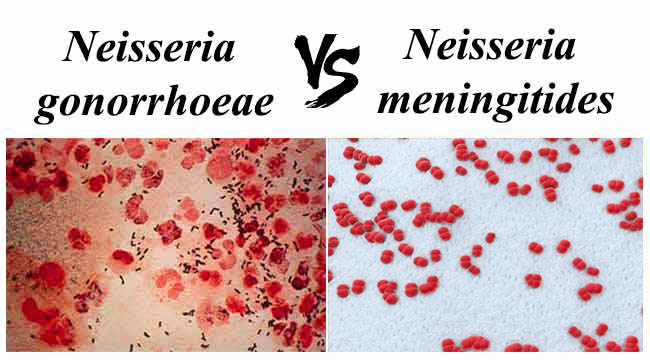Neisseria gonorrhoeae and Neisseria meningitidis are both Gram Negative Bacteria. They are diplococci, non-sporing, non-motile and oxidase positive. But they have some differences which are as follows:
| S.N. | Characteristics | Neisseria gonorrhoeae | Neisseria meningitidis |
|---|---|---|---|
| 1 | Referred as | Referred to as gonococcus. | Referred to as meningococcus. |
| 2 | Agents | N. gonorrhoeae is the agent of gonorrhoea. | N. meningitidis is a major cause of cerebrospinal meningitis. |
| 3 | Vaccine Development | No | Serogroup A, B, C, Y and W-135 meningococcal infections can be prevented by vaccines. |
| 4 | Colony Morphology | N. gonorrhoeae form smooth, round, moist, uniform
grey/brown colonies with a greenish color underneath on primary isolation medium. | N. meningitides would form smooth, round, moist, uniform
large grey/brown colonies with a glistening surface and entire edges. |
| 5 | Morphology | N. gonorrhoea is kidney shaped with apposing ends concave. | N. meningitidis is semicircular diplococcus with flat apposing ends. |
| 6 | Autolyse | May autolyse | Autolyse |
| 7 | Maltose Fermentation | No | Yes |
| 8 | Nitrite Reduction | N. gonorrhoeae doesn’t reduce nitrites. | N. meningitidis can reduce nitrites in low concentrations. |
| 9 | Growth on Blood Agar | N. gonorrhoeae grow less
well on blood agar than N. meningitidis. | N. meningitidis grow well on blood agar than N. gonorrhoeae. |
| 10 | Capsule | No | Yes. The capsule is anti-phagocytic and is an important virulence factor. |
| 11 | Site of Infection | Primarily causing infection of the anogenital tract. | Colonizes the upper respiratory tract as a commensal and occasionally invades to
cause systemic disease. |
| 12 | Pathogens | It is always considered a pathogen. | It is not always considered as pathogens. |
| 13 | Enzyme Production | It doesn’t produce gamma-glutamylaminotransferase. | It produces gamma-glutamylaminotransferase. |
| 14 | Specimen Collection | Transport swab of endocervix, urethra, rectum, pharynx, conjunctiva, blood, joint fluid, aspirates from skin lesions. | Collect cerebrospinal fluid (CSF) and blood, swab skin lesions and nasopharynx. |
| 15 | Β-Lactamase Production | Common | Rare |
| 16 | Movement | Movement of N. gonorrhoeae occurs at lower speed. | Movement of N. meningitidis occurred at higher speed and with a larger number of retracting pili. |
| 17 | Pili | N. gonorrhoeae most often moved using one retracting pilus. | N. meningitidis most often used four pili. |
| 18 | Prevalence and Mortality | N. gonorrhoeae infections have a high prevalence and low mortality | N. meningitidis infections have a low prevalence and high mortality. |
| 19 | Superbug | Considered as “superbug” | Not considered as “superbug” |
| 20 | Pathogenesis | N. gonorrhoeae can also cause conjunctivitis, pharyngitis, proctitis or urethritis, prostatitis, and orchitis. | Cause meningitis and other forms of meningococcal disease such as meningococcemia, a life-threatening sepsis. |
Similar Posts:
- Cryptococcus Neoformans – Habitat, Morphology, Epidemiology, Virulence Factors, Treatment + More
- Normal Laboratory Values of Blood, Plasma, Serum, Urine, CSF and Stool
- Blood cells and its types with functions
- Histoplasma Capsulatum – Habitat, Morphology, Epidemiology, Virulence Factors, Treatment + More


What is the biochemical test that differentiate them(N. gonorrhea from N. meningitis)?
Fermentacion de carbohidratos
N.gonorrhoeae -> Glucosa
N. meningitidis -> Glucosa y maltosa
Mortality rate of both is almost zero. Case fatality rate of N. meningitidis meningitis or sepsis is consistent. Mortality rate refers to deaths/population size.
N. “g”onorrhea = Glucose Fermenter
N. “m”enin”g”itidis = Maltose & Glucose Fermenter
you’re welcome! ☺ 🙂
Thank you, I’m actually finding that way too helpful!!! Awesome!
Hello, it is N. meningitidis, ending with “-is”, not “-es”